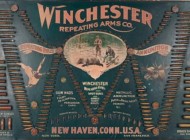SACRAMENTO, CALIF. — Part 2 of the Mel Hammer bottle collection — gathered over a 50-year span by a man who dedicated much of his adult life to the acquisition and study of antique glass — was sold in an online auction that closed on March 14 by American Bottle Auctions. The offerings featured Hammer’s favorites, including schnapps and gin bottles, bitters bottles and inkwells, many boasting 9.5 grades. Hammer died on Thanksgiving Day 2021.
Leading the sale at $29,900, a new auction record, was a Miller’s Ratafia Bitters. American Bottle Auctions owner Jeff Wichmann said, “No example has sold for more than $1,400 that we are aware of.” These interesting bottles are known by collectors as the odd sized whiskey-shaped amber bottle but mostly they are the antique bottle with a Sphinx on it. “Collectors of Western bitters and bottles in general are always on the lookout for picture whiskeys, and although we’ve seen race horses, eagles, a Phoenix and deer and elk heads, along with a lot more, to our knowledge this is the only Western-made bitters made with a picture of a Sphinx prominently displayed front and center on the bottle.
The Miller’s Ratafia were made from around 1878 to 1882. The earliest known address for the Siebe Brothers was on the southwest corner of Pacific and Stockton Streets in San Francisco in 1859. Later the store became the property of John Siebe and moved to Union and Powell Streets. Eventually John got back together with his brother Frederick and they opened a grocery liquor store around 1866. By 1877 they created their own wholesale liquor company and decided they needed to furnish their own bitters product. They met a Dr Charles P. Miller, who happened to be a noted physician in San Francisco at the time and hired him to concoct a bitters in which they could bottle and distribute with their name.
The Miller bottles come in a sixth size and are always shades of amber. These hard-to-find Western bitters have been mostly dug in California, Vallejo, Mariposa and Nevada City and in neighboring states, including Nevada. “We don’t often hear much about a Miller’s Ratafia changing hands, we believe that’s because there just aren’t enough to go around,” said Wichmann. “Collectors who own one rarely want to part with them, and new finds are quickly bought up. Since they are so hard to find collectors pay a premium.”
A further review will follow with additional highlights from the sale.





